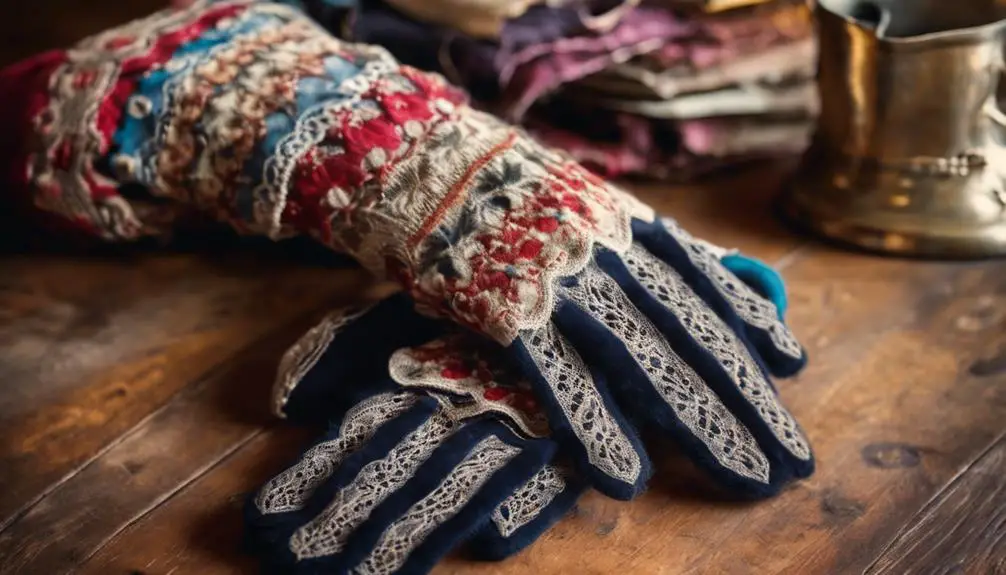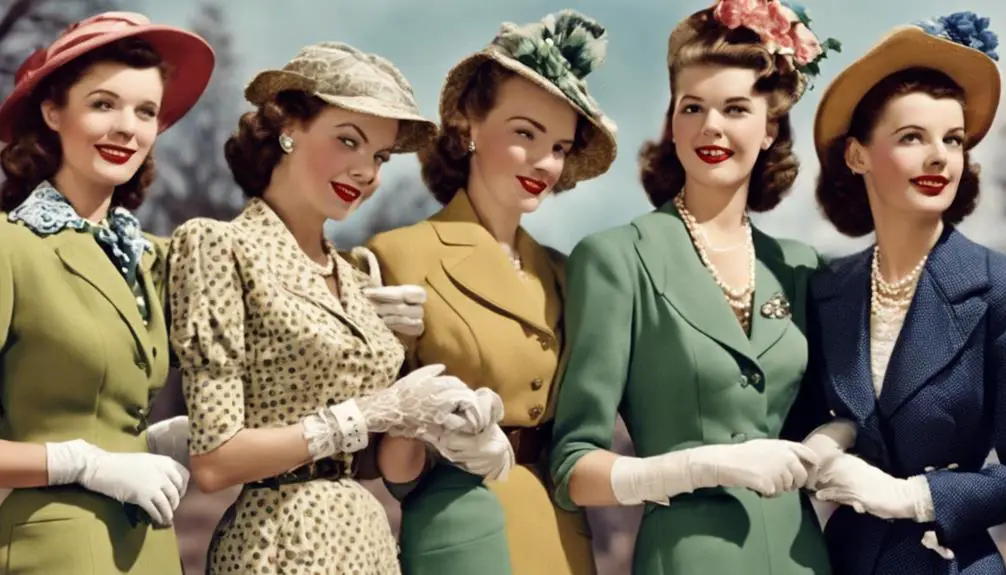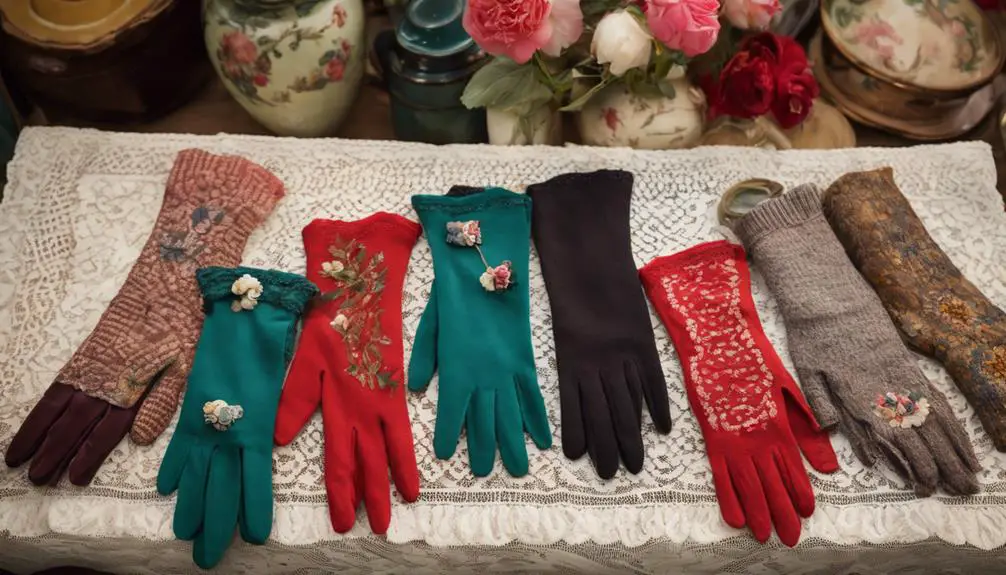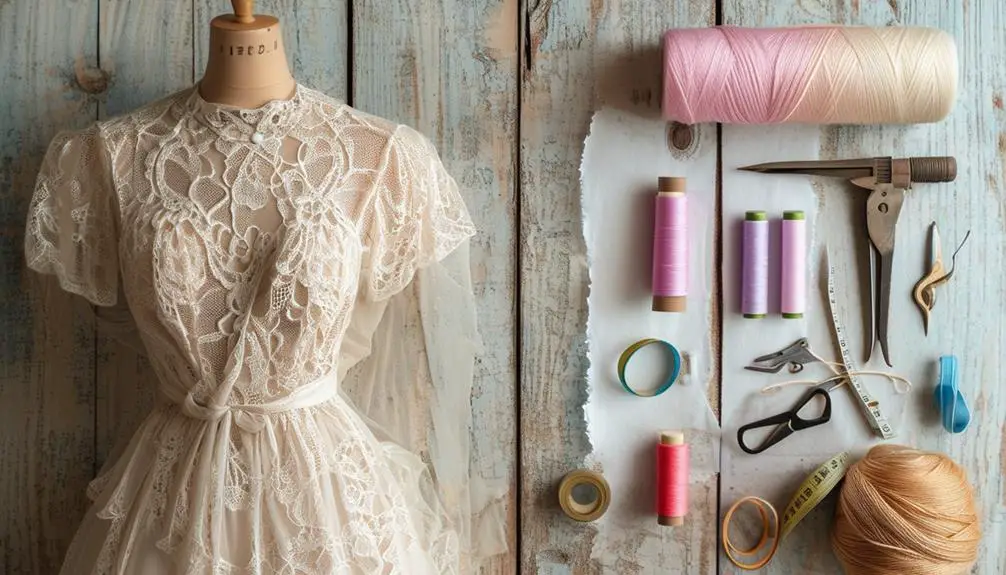In the 1940s, women's fingerless gloves became essential accessories that balanced functionality with style. Crafted from breathable materials like cotton and wool, they were designed for women in factories who needed dexterity for their tasks. You'd notice varied styles, from wrist-length to mid-arm, reflecting both workforce demands and post-war optimism. Embellishments like scalloped edges and decorative stitching transformed these gloves into fashionable items, allowing women to express their individuality. As demand for these chic yet practical accessories grew, they evolved into collectable pieces. Discover more about their cultural significance and design trends that shaped this iconic accessory era.
Evolution of Fingerless Gloves

Fingerless gloves evolved markedly during the 1940s, adapting to the unique demands of a world at war. As practicality became paramount during WWII, these accessories emerged as essential tools for women engaging in factory work and other roles requiring dexterity. The exposure of fingers allowed for precision in gripping tools and handling materials, making fingerless gloves ideal for wartime labor.
Crafted from cotton and wool, these gloves offered warmth without sacrificing functionality. The design varied greatly, ranging from wrist-length to mid-arm styles, reflecting both the changing needs of the workforce and contemporary fashion trends. This variation not only served practical purposes but also allowed women to maintain a sense of femininity amidst the harsh realities of war.
Common embellishments like decorative stitching added aesthetic appeal, transforming fingerless gloves into fashionable items that signified a shift in social norms. They became symbols of women's dual roles—practical work accessories that also celebrated femininity during a time of considerable social change. In this situation, fingerless gloves represent a remarkable blend of utility and style, encapsulating the spirit of resilience and adaptability during the 1940s.
Materials and Design Features
The materials chosen for women's fingerless gloves in the 1940s played an essential role in balancing functionality with fashion. Crafted from cotton, lace, and lightweight fabrics, these gloves allowed for breathability and ease of movement, which was particularly important during wartime material restrictions. The use of these fabrics not only guaranteed comfort but also aligned with the era's aesthetic values.
Design features further enhanced their appeal. Intricate embroidery adorned many pairs, adding a touch of elegance that elevated these practical accessories. Scalloped edges and decorative elements like buttons and rhinestones provided additional visual interest, transforming the gloves into fashionable statements. Popular colors, including pastel shades, black, and ivory, emphasized the feminine charm that characterized the decade.
Moreover, many designs showcased hand-crocheted patterns, highlighting individual craftsmanship amidst the growing trend of mass production. This blend of functional and fashionable elements allowed women to retain dexterity while maneuvering the evolving styles of the time. Fingerless gloves consequently became not just practical items, but essential accessories that reflected the spirit of resilience and creativity during the 1940s.
Popular Styles of the 1940s

During the 1940s, women's fingerless gloves emerged as a fashionable accessory that seamlessly integrated style and utility. These gloves typically featured a snug fit and were crafted from breathable materials like knit or crochet, allowing you to retain dexterity while engaging in wartime activities. The wrist-length designs became particularly popular, striking a balance between practicality and elegance, making them ideal for both work and leisure.
Decorative elements, such as scalloped edges and intricate embroidery, enhanced the feminine appeal, transforming fingerless gloves into a statement piece within your wardrobe. As the decade progressed, vibrant colors and playful designs reflected a post-war optimism, encouraging you to embrace expressive fashion. This shift allowed women to reclaim their social roles and showcase individuality through their style choices.
Fingerless gloves proved to be a versatile accessory, suitable for various social settings—from casual outings to formal events. They effortlessly complemented outfits, making them an essential addition to women's wardrobes in the 1940s. By blending practicality with decorative flair, fingerless gloves captured the essence of the era, symbolizing resilience and a renewed sense of self-expression.
Cultural Significance and Usage
As a practical yet stylish accessory, women's fingerless gloves in the 1940s embodied the cultural shifts of the era. These gloves weren't just about warmth; they represented a blend of functionality and fashion, reflecting women's evolving roles during a time of significant change. The wartime context led many women to showcase their resourcefulness by creating homemade fingerless gloves, often using scraps of fabric to craft intricate lace and crochet designs. The unique designs and craftsmanship of these gloves can often be identified through vintage labels, making them valuable pieces for collectors interested in vintage clothing characteristics.
Consider the various aspects that made these gloves culturally significant:
- Practicality: They allowed women to maintain dexterity while performing tasks.
- Fashion accessory: The decorative designs added elegance to everyday outfits.
- Outdoor activities: They were ideal for social gatherings and leisure pursuits.
- Resourcefulness: Making gloves from leftover materials symbolized resilience and creativity.
- Individuality: Women expressed personal style through unique patterns and colors.
In this way, fingerless gloves became more than mere garments; they were emblematic of a generation embracing independence and creativity, all while maneuvering through the challenges of the 1940s.
Collectibility and Market Trends

Collectors and fashion enthusiasts have increasingly recognized the value of 1940s fingerless gloves, not just as historical artifacts but as stylish accessories that resonate with current trends. The unique designs and wartime practicality of these vintage gloves create a compelling narrative that appeals to a growing audience. Understanding the importance of vintage clothing labels can further enhance this appreciation, as these tags often provide insights into the garment's provenance and authenticity vintage tag significance. As you explore the market, you'll notice that demand for 1940s fingerless gloves has surged, with prices ranging from $4.60 to over $200 based on condition, material, and brand.
Specific styles like crochet and beaded gloves are particularly sought after, enhancing their collectibility among discerning buyers. Online marketplaces have emerged as key platforms for these transactions, with auction-style listings and "Best Offer" options allowing for dynamic negotiations. This environment fosters a vibrant community of fashion enthusiasts who share a passion for nostalgia and historical fashion.
The intersection of vintage charm and contemporary style is driving market trends, making 1940s fingerless gloves more desirable than ever. As you navigate this landscape, keep an eye on the evolving preferences of collectors, as they may influence future values and availability in the ever-changing world of vintage fashion.
Frequently Asked Questions
What Decade Were Fingerless Gloves Popular?
Fingerless gloves gained popularity in the 1940s, reflecting a blend of necessity and style. You'll find they offered practicality for various activities, evolving into fashionable accessories that shaped trends throughout the decade and beyond.
What Was the Point of Fingerless Gloves?
Fingerless gloves serve a dual purpose: they keep your hands warm while allowing full dexterity for tasks. Their design combines style and functionality, making them versatile accessories suitable for various activities, from driving to social gatherings.
Who Popularized Fingerless Gloves?
You'll find that fingerless gloves gained popularity through influential figures in fashion and cinema. Icons like Katharine Hepburn and Bette Davis showcased them, blending practicality with style, further enhancing their status as fashionable accessories.
What Are the Fingerless Gloves Called?
You'll find fingerless gloves often referred to as "mitts." These accessories blend practicality with style, allowing your fingers freedom of movement while keeping your wrists warm, making them a versatile choice for various occasions.




